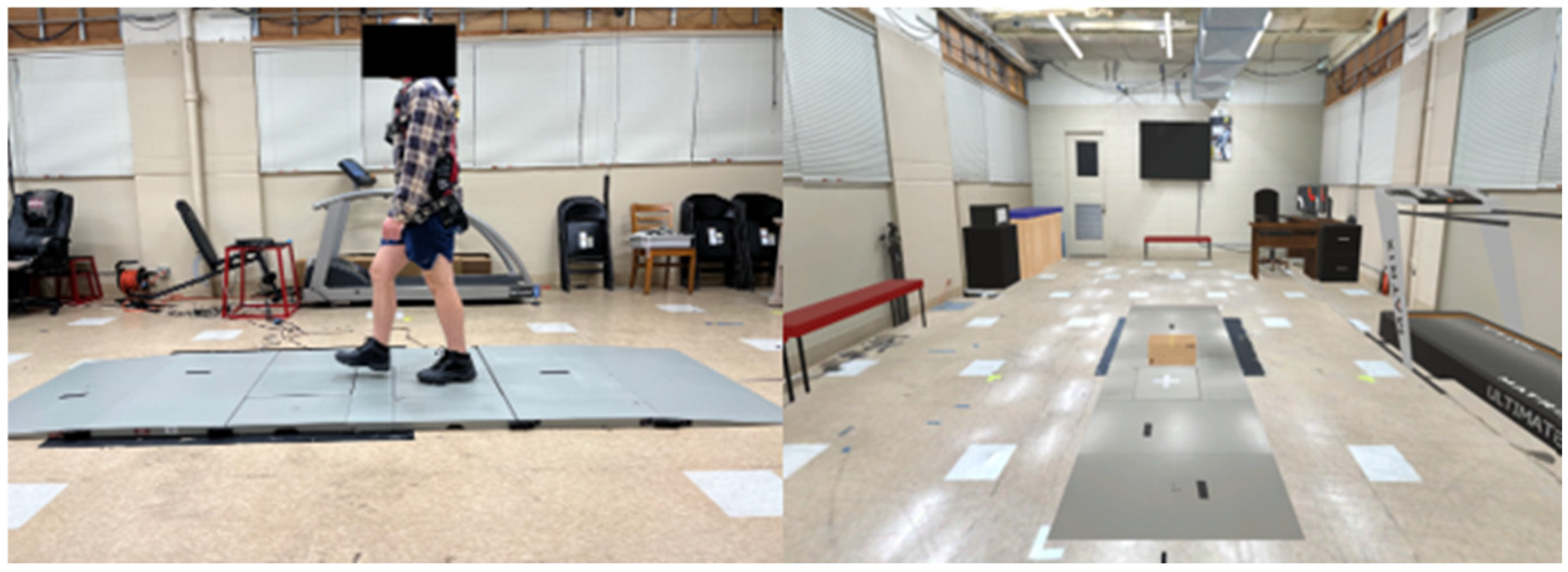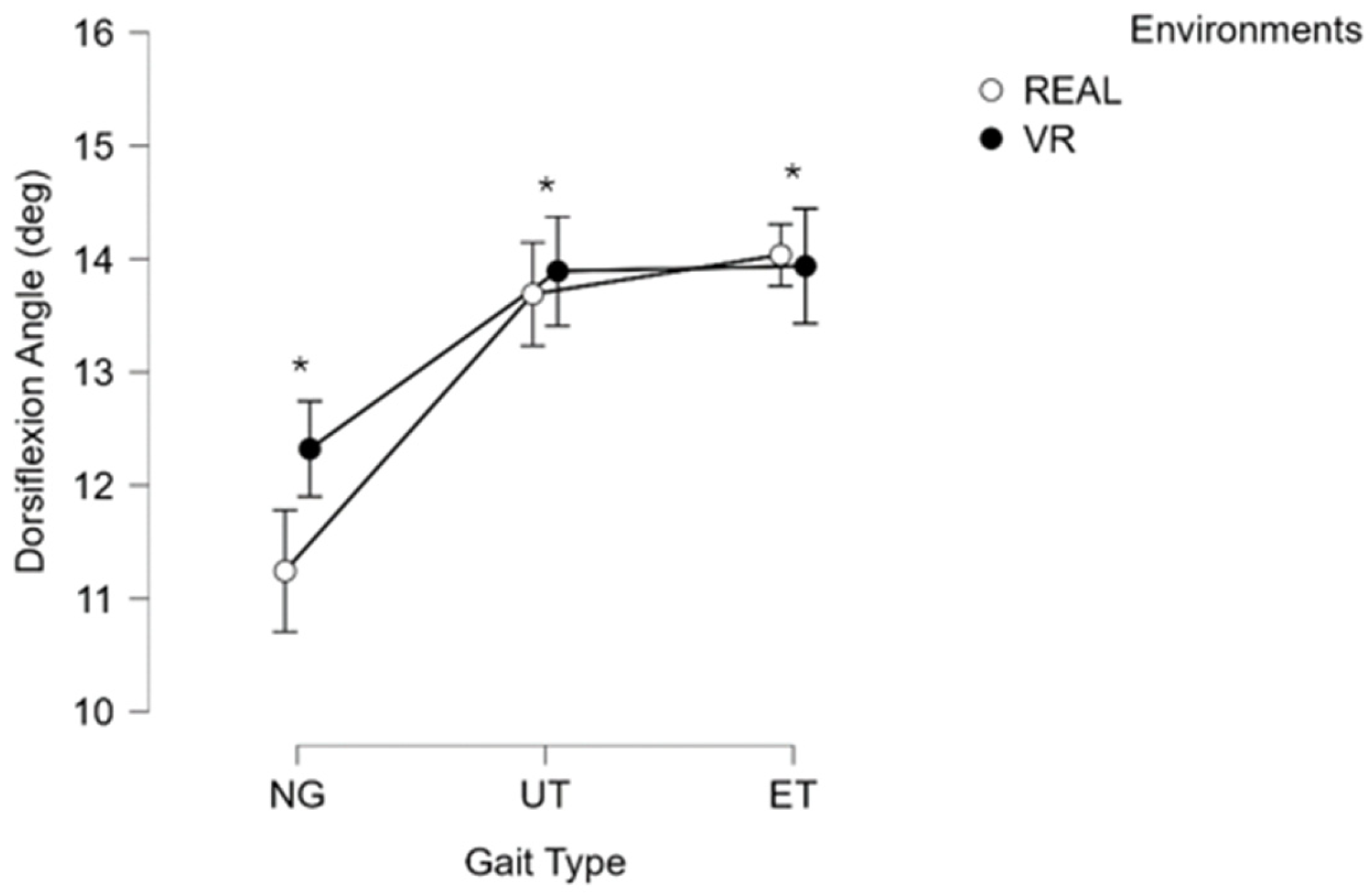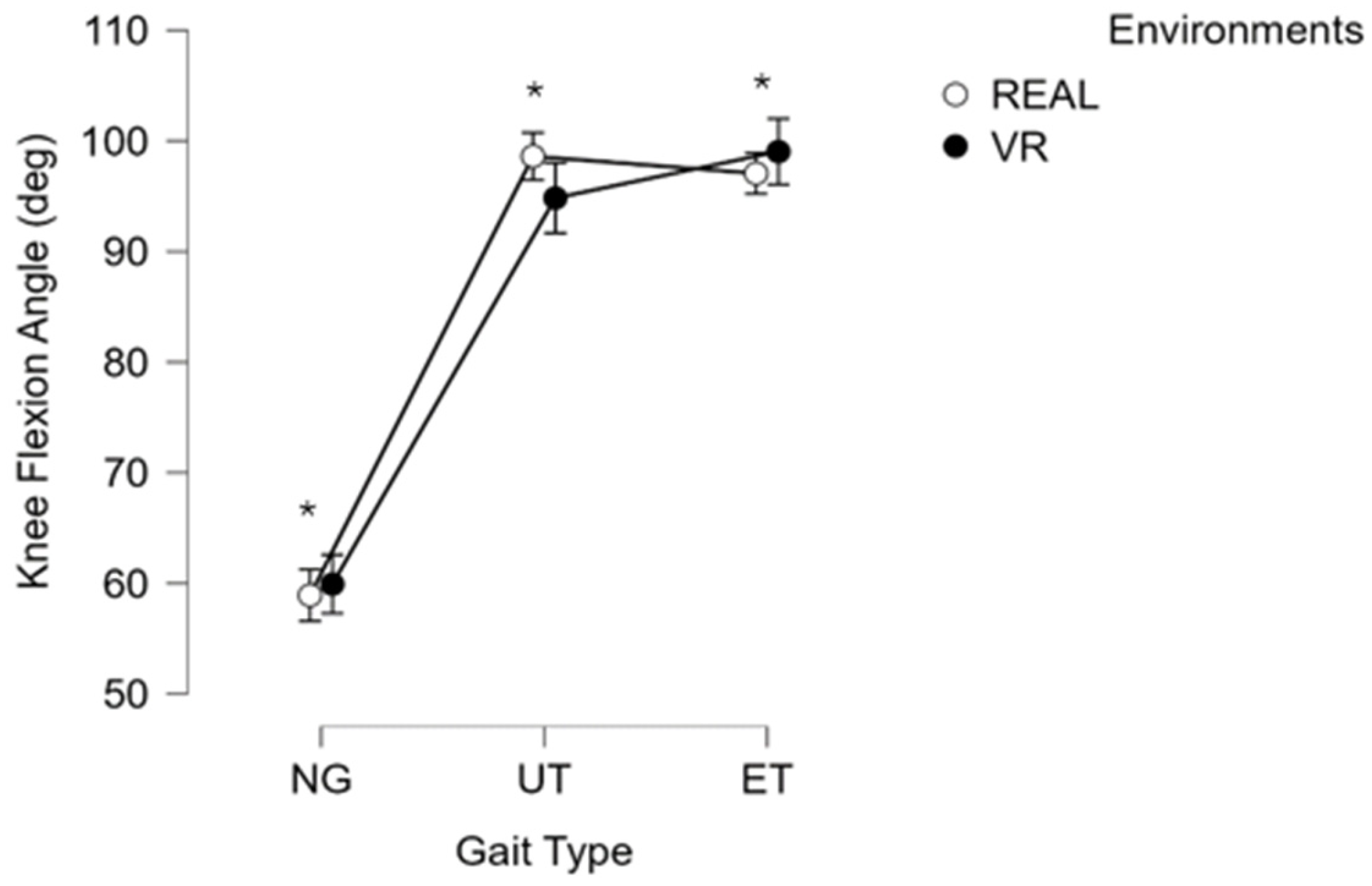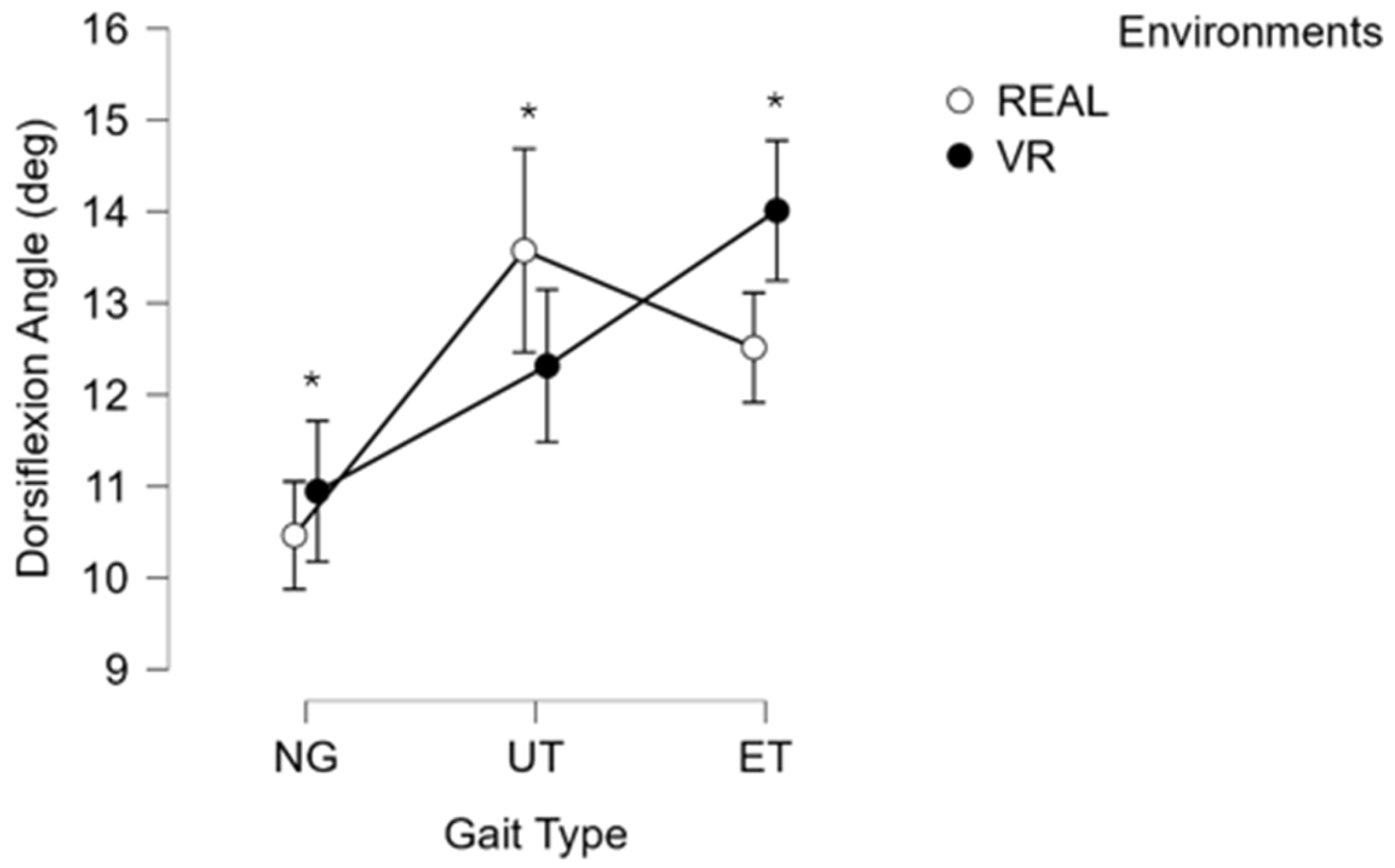Influence of Virtual Reality on Lower Extremity Joint Kinematics During Overground Walking
Abstract
1. Introduction
2. Materials and Methods
2.1. Participants
2.2. Study Design
2.3. Instrumentation
2.4. Experimental Procedures
2.5. Data Analysis
2.6. Statistical Analyses
3. Results
3.1. Lead Leg Kinematics
3.2. Trail Leg Kinematics
4. Discussion
5. Conclusions
Author Contributions
Funding
Institutional Review Board Statement
Informed Consent Statement
Data Availability Statement
Conflicts of Interest
References
- CDC. Older Adult Falls Data. Older Adult Fall Prevention. 2024. Available online: https://www.cdc.gov/falls/data-research/index.html (accessed on 30 July 2025).
- Zahedian-Nasab, N.; Jaberi, A.; Shirazi, F.; Kavousipor, S. Effect of virtual reality exercises on balance and fall in elderly people with fall risk: A randomized controlled trial. BMC Geriatr. 2021, 21, 509. [Google Scholar] [CrossRef] [PubMed]
- Ambrose, A.F.; Paul, G.; Hausdorff, J.M. Risk factors for falls among older adults: A review of the literature. Maturitas 2013, 75, 51–61. [Google Scholar] [CrossRef] [PubMed]
- Winter, D. Human balance and posture control during standing and walking. Gait Posture 1995, 3, 193–214. [Google Scholar] [CrossRef]
- Park, S.; Horak, F.B.; Kuo, A.D. Postural feedback responses scale with biomechanical constraints in human standing. Exp. Brain Res. 2004, 154, 417–427. [Google Scholar] [CrossRef]
- Zelei, A.; Milton, J.; Stepan, G.; Insperger, T. Response to perturbation during quiet standing resembles delayed state feedback optimized for performance and robustness. Sci. Rep. 2021, 11, 11392. [Google Scholar] [CrossRef]
- Pavol, M.J.; Owings, T.M.; Foley, K.T.; Grabiner, M.D. Mechanisms Leading to a Fall From an Induced Trip in Healthy Older Adults. J. Gerontol. Ser. A 2001, 56, M428–M437. [Google Scholar] [CrossRef]
- Klous, M.; Mikulic, P.; Latash, M.L. Two aspects of feedforward postural control: Anticipatory postural adjustments and anticipatory synergy adjustments. J. Neurophysiol. 2011, 105, 2275–2288. [Google Scholar] [CrossRef]
- Zehr, E.P.; Stein, R.B. What functions do reflexes serve during human locomotion? Prog. Neurobiol. 1999, 58, 185–205. [Google Scholar] [CrossRef]
- Panfili, D.P. The Role of Vision in Locomotion. Ph.D. Thesis, The University of Texas at Austin, Austin, TX, USA, 2023. Available online: https://hdl.handle.net/2152/123321 (accessed on 21 April 2025).
- Santos, L.C.; Moraes, R.; Patla, A.E. Visual Feedforward Control in Human Locomotion During Avoidance of Obstacles that Change Size. Mot. Control 2010, 14, 424–439. Available online: https://journals.humankinetics.com/view/journals/mcj/14/4/article-p424.xml (accessed on 21 April 2025). [CrossRef]
- Patla, A.E. Understanding the roles of vision in the control of human locomotion. Gait Posture 1997, 5, 54–69. [Google Scholar] [CrossRef]
- Lajoie, K.; Bloomfield, L.W.; Nelson, F.J.; Suh, J.J.; Marigold, D.S. The contribution of vision, proprioception, and efference copy in storing a neural representation for guiding trail leg trajectory over an obstacle. J. Neurophysiol. 2012, 107, 2283–2293. [Google Scholar] [CrossRef]
- Patla, A.E.; Rietdyk, S.; Martin, C.; Prentice, S. Locomotor Patterns of the Leading and the Trailing Limbs as Solid and Fragile Obstacles are Stepped over: Some Insights into the Role of Vision During Locomotion. J. Mot. Behav. 1996, 28, 35–47. [Google Scholar] [CrossRef]
- Fotios, S.; Uttley, J. Illuminance required to detect a pavement obstacle of critical size. Light. Res. Technol. 2018, 50, 390–404. [Google Scholar] [CrossRef]
- Shiratori, T.; Coley, B.; Cham, R.; Hodgins, J.K. Simulating balance recovery responses to trips based on biomechanical principles. In Proceedings of the 2009 ACM SIGGRAPH/Eurographics Symposium on Computer Animation, New York, NY, USA, 3–7 August 2009; pp. 37–46. Available online: https://dl.acm.org/doi/10.1145/1599470.1599475 (accessed on 10 June 2024).
- Siragy, T.; Russo, Y.; Young, W.; Lamb, S.E. Comparison of over-ground and treadmill perturbations for simulation of real-world slips and trips: A systematic review. Gait Posture 2023, 100, 201–209. [Google Scholar] [CrossRef] [PubMed]
- Grabiner, M.D.; Donovan, S.; Bareither, M.L.; Marone, J.R.; Hamstra-Wright, K.; Gatts, S.; Troy, K.L. Trunk kinematics and fall risk of older adults: Translating biomechanical results to the clinic. J. Electromyogr. Kinesiol. 2008, 18, 197–204. [Google Scholar] [CrossRef] [PubMed]
- Barrett, R.S.; Mills, P.M.; Begg, R.K. A systematic review of the effect of ageing and falls history on minimum foot clearance characteristics during level walking. Gait Posture 2010, 32, 429–435. [Google Scholar] [CrossRef]
- Winter, D.A. Foot Trajectory in Human Gait: A Precise and Multifactorial Motor Control Task. Phys. Ther. 1992, 72, 45–53. [Google Scholar] [CrossRef]
- Begg, R.; Best, R.; Dell’Oro, L.; Taylor, S. Minimum foot clearance during walking: Strategies for the minimisation of trip-related falls. Gait Posture 2007, 25, 191–198. [Google Scholar] [CrossRef]
- Austin, G.P.; Garrett, G.E.; Bohannon, R.W. Kinematic analysis of obstacle clearance during locomotion. Gait Posture 1999, 10, 109–120. [Google Scholar] [CrossRef]
- Kozak, J.J.; Hancock, P.A.; Arthur, E.J.; Chrysler, S.T. Transfer of training from virtual reality. Ergonomics 1993, 36, 777–784. Available online: https://www.tandfonline.com/doi/abs/10.1080/00140139308967941 (accessed on 21 April 2025). [CrossRef]
- Xie, B.; Liu, H.; Alghofaili, R.; Zhang, Y.; Jiang, Y.; Lobo, F.D.; Li, C.; Li, W.; Huang, H.; Akdere, M.; et al. A Review on Virtual Reality Skill Training Applications. Front. Virtual Real. 2021, 2, 645153. Available online: https://www.frontiersin.org/journals/virtual-reality/articles/10.3389/frvir.2021.645153/full (accessed on 25 April 2025). [CrossRef]
- Mao, Y.; Chen, P.; Li, L.; Huang, D. Virtual reality training improves balance function. Neural Regen. Res. 2014, 9, 1628–1634. [Google Scholar] [CrossRef] [PubMed]
- Mirelman, A.; Patritti, B.L.; Bonato, P.; Deutsch, J.E. Effects of virtual reality training on gait biomechanics of individuals post-stroke. Gait Posture 2010, 31, 433–437. [Google Scholar] [CrossRef] [PubMed]
- Villiger, M.; Bohli, D.; Kiper, D.; Pyk, P.; Spillmann, J.; Meilick, B.; Curt, A.; Hepp-Reymond, M.-C.; Hotz-Boendermaker, S.; Eng, K. Virtual Reality–Augmented Neurorehabilitation Improves Motor Function and Reduces Neuropathic Pain in Patients With Incomplete Spinal Cord Injury. Neurorehabilit. Neural Repair 2013, 27, 675–683. [Google Scholar] [CrossRef] [PubMed]
- You, S.H.; Jang, S.H.; Kim, Y.H.; Hallett, M.; Ahn, S.H.; Kwon, Y.H.; Kim, J.H.; Lee, M.Y. Virtual Reality–Induced Cortical Reorganization and Associated Locomotor Recovery in Chronic Stroke: An Experimenter-Blind Randomized Study. Stroke 2005, 36, 1166–1171. [Google Scholar] [CrossRef]
- Feitosa, J.A.; Fernandes, C.A.; Casseb, R.F.; Castellano, G. Effects of virtual reality-based motor rehabilitation: A systematic review of fMRI studies. J. Neural Eng. 2022, 19, 011002. [Google Scholar] [CrossRef]
- Kim, A.; Zhou, Z.; Kretch, K.S.; Finley, J.M. Manipulating the fidelity of lower extremity visual feedback to identify obstacle negotiation strategies in immersive virtual reality. In Proceedings of the 39th Annual International Conference of the IEEE Engineering in Medicine and Biology Society (EMBC), Jeju Island, Republic of Korea, 11–15 July 2017; pp. 4491–4494. Available online: https://ieeexplore.ieee.org/abstract/document/8037854?casa_token=bPlycnVFl20AAAAA:6oHjAT1VvB5XkA-9oOaNu6GAUknfnlgx2Eh4WnX69XOzzAyqtiUuHs23ZGn1xT5NmiOTu4y1cnE (accessed on 21 June 2024).
- Kim, A.; Kretch, K.S.; Zhou, Z.; Finley, J.M. The quality of visual information about the lower extremities influences visuomotor coordination during virtual obstacle negotiation. J. Neurophysiol. 2018, 120, 839–847. [Google Scholar] [CrossRef]
- Kim, S.; Joo, K.S.; Liu, J.; Sohn, J.H. Lower extremity kinematics during forward heel-slip. Technol. Health Care 2019, 27, 345–356. [Google Scholar] [CrossRef]
- Serchi, V. Gaze Strategies During Obstacle Negotiation in the Presence of Distractors: A Virtual Reality Based Assessment. Ph.D. Thesis, Alma Mater Studiorum, Bologna, Italy, 2017. Available online: http://amsdottorato.unibo.it/id/eprint/7840 (accessed on 21 April 2025).
- Riley, P.O.; Paolini, G.; Della Croce, U.; Paylo, K.W.; Kerrigan, D.C. A kinematic and kinetic comparison of overground and treadmill walking in healthy subjects. Gait Posture 2007, 26, 17–24. [Google Scholar] [CrossRef]
- Ochoa, J.; Sternad, D.; Hogan, N. Treadmill vs. overground walking: Different response to physical interaction. J. Neurophysiol. 2017, 118, 2089–2102. [Google Scholar] [CrossRef]
- Semaan, M.B.; Wallard, L.; Ruiz, V.; Gillet, C.; Leteneur, S.; Simoneau-Buessinger, E. Is treadmill walking biomechanically comparable to overground walking? A systematic review. Gait Posture 2022, 92, 249–257. [Google Scholar] [CrossRef] [PubMed]
- Kennedy, R.S.; Lane, N.E.; Berbaum, K.S.; Lilienthal, M.G. Simulator Sickness Questionnaire: An Enhanced Method for Quantifying Simulator Sickness. Int. J. Aviat. Psychol. 1993, 3, 203–220. [Google Scholar] [CrossRef]
- Bimberg, P.; Weissker, T.; Kulik, A. On the Usage of the Simulator Sickness Questionnaire for Virtual Reality Research. In Proceedings of the 2020 IEEE Conference on Virtual Reality and 3D User Interfaces Abstracts and Workshops (VRW), Atlanta, GA, USA, 22–26 March 2020; pp. 464–467. Available online: https://ieeexplore.ieee.org/document/9090573/ (accessed on 26 September 2023).
- Lee, B.C.; Kim, C.S.; Seo, K.H. The Body’s Compensatory Responses to Unpredictable Trip and Slip Perturbations Induced by a Programmable Split-Belt Treadmill. IEEE Trans. Neural Syst. Rehabil. Eng. 2019, 27, 1389–1396. [Google Scholar] [CrossRef]
- Arlati, S.; Keijsers, N.; Paolini, G.; Ferrigno, G.; Sacco, M. Kinematics of aimed movements in ecological immersive virtual reality: A comparative study with real world. Virtual Real. 2022, 26, 885–901. [Google Scholar] [CrossRef]
- Koritnik, T.; Bajd, T.; Munih, M. Virtual environment for lower-extremities training. Gait Posture 2008, 27, 323–330. [Google Scholar] [CrossRef]
- Burcal, C.J.; Haggerty, A.; Grooms, D.R. Using Virtual Reality to Treat Perceptual and Neurocognitive Impairments After Lower Extremity Injury. Athl. Train. Sports Health Care 2021, 13, e453–e459. [Google Scholar]
- Kim, J.H.; Jang, S.H.; Kim, C.S.; Jung, J.H.; You, J.H. Use of Virtual Reality to Enhance Balance and Ambulation in Chronic Stroke: A Double-Blind, Randomized Controlled Study. Am. J. Phys. Med. Rehabil. 2009, 88, 693–701. [Google Scholar]
- Phu, S.; Vogrin, S.; Al Saedi, A.; Duque, G. Balance training using virtual reality improves balance and physical performance in older adults at high risk of falls. Clin. Interv. Aging 2019, 14, 1567–1577. [Google Scholar] [CrossRef]
- Segear, S.; Chheang, V.; Baron, L.; Li, J.; Kim, K.; Barmaki, R.L. Visual feedback and guided balance training in an immersive virtual reality environment for lower extremity rehabilitation. Comput. Graph. 2024, 119, 103880. [Google Scholar] [CrossRef]
- Ranjbarzadeh Yamchi, F.; Letafatkar, A.; Esmaeilpour, S. The Effect of 8 Weeks Virtual Reality Training on Static and Dynamic Balance and Performance in Male Athletes with Functional Ankle Instabilit. Specif. Phys. Ther. J. 2021, 11, 45–54. [Google Scholar] [CrossRef]
- Kim, K.J.; Heo, M. Effects of virtual reality programs on balance in functional ankle instability. J. Phys. Ther. Sci. 2015, 27, 3097–3101. [Google Scholar] [CrossRef]
- Elaraby, A.E.R.; Shahien, M.; Jahan, A.M.; Etoom, M.; Bekhet, A.H. The Efficacy of Virtual Reality Training in the Rehabilitation of Orthopedic Ankle Injuries: A Systematic Review and Meta-analysis. Adv. Rehabil. Sci. Pract. 2023, 12, 11795727231151636. [Google Scholar] [CrossRef]
- Pearson, K.G. Generating the walking gait: Role of sensory feedback. Prog. Brain Res. 2004, 143, 123–129. Available online: https://www.sciencedirect.com/science/article/pii/S0079612303430124 (accessed on 6 May 2025). [PubMed]
- Gunjan, J.; Shefali, W.; Majumi, N.M. Effect of Obstacle Negotiation Training on Gait Parameters in Individuals with Idiopathic Parkinson’s Disease. Indian J. Physiother. Occup. Ther. 2013, 7, 52–57. [Google Scholar] [CrossRef]
- Yamada, M.; Aoyama, T.; Arai, H.; Nagai, K.; Tanaka, B.; Uemura, K.; Mori, S.; Ichihashi, N. Complex obstacle negotiation exercise can prevent falls in community-dwelling elderly Japanese aged 75 years and older. Geriatr. Gerontol. Int. 2012, 12, 461–467. [Google Scholar] [CrossRef] [PubMed]
- Eyal, S.; Kurz, I.; Mirelman, A.; Maidan, I.; Giladi, N.; Hausdorff, J.M. Successful Negotiation of Anticipated and Unanticipated Obstacles in Young and Older Adults: Not All Is as Expected. Gerontology 2019, 66, 187–196. [Google Scholar] [CrossRef]
- Brown, L.A.; Doan, J.B.; McKenzie, N.C.; Cooper, S.A. Anxiety-mediated gait adaptations reduce errors of obstacle negotiation among younger and older adults: Implications for fall risk. Gait Posture 2006, 24, 418–423. [Google Scholar] [CrossRef]
- Kim, A.; Schweighofer, N.; Finley, J.M. Locomotor skill acquisition in virtual reality shows sustained transfer to the real world. J. Neuroeng. Rehabil. 2019, 16, 113. [Google Scholar] [CrossRef]
- Tzvi, E.; Zimmermann, C.; Bey, R.; Münte, T.F.; Nitschke, M.; Krämer, U.M. Cerebellar degeneration affects cortico-cortical connectivity in motor learning networks. NeuroImage: Clin. 2017, 16, 66–78. [Google Scholar] [CrossRef]
- Horsak, B.; Simonlehner, M.; Dumphart, B.; Siragy, T. Overground walking while using a virtual reality head mounted display increases variability in trunk kinematics and reduces dynamic balance in young adults. Virtual Real. 2023, 27, 3021–3032. [Google Scholar] [CrossRef]
- Dos Santos Mendes, F.A.; Pompeu, J.E.; Lobo, A.M.; da Silva, K.G.; de Paula Oliveira, T.; Zomignani, A.P.; Piemonte, M.E.P. Motor learning, retention and transfer after virtual-reality-based training in Parkinson’s disease—Effect of motor and cognitive demands of games: A longitudinal, controlled clinical study. Physiotherapy 2012, 98, 217–223. [Google Scholar] [CrossRef]
- Triegaardt, J.; Han, T.S.; Sada, C.; Sharma, S.; Sharma, P. The role of virtual reality on outcomes in rehabilitation of Parkinson’s disease: Meta-analysis and systematic review in 1031 participants. Neurol. Sci. 2020, 41, 529–536. [Google Scholar] [CrossRef]
- Shideler, B.L.; Martelli, D.; Prado, A.; Agrawal, S.K. Overground gait training using virtual reality aimed at gait symmetry. Hum. Mov. Sci. 2021, 76, 102770. [Google Scholar] [CrossRef]
- Rodrigues, S.T.; Gotardi, G.C.; Aguiar, S.A. Effects of Vision on Postural Control in Neurologically Healthy Individuals. In Locomotion and Posture in Older Adults: The Role of Aging and Movement Disorders; Barbieri, F.A., Vitório, R., Eds.; Springer International Publishing: Cham, Switzerland, 2017; pp. 219–236. [Google Scholar] [CrossRef]







| Environment | Joint | Leg | NG (Degrees) | UT (Degrees) | ET (Degrees) |
|---|---|---|---|---|---|
| REAL | Plantarflexion | Lead | −17.90 ± 6.39 | −19.58 ± 7.92 | −18.20 ± 8.63 |
| Trail | −22.92 ± 8.84 | −27.10 ± 12.34 | −23.61 ± 9.31 | ||
| Dorsiflexion | Lead | 11.24 ± 4.91 | 13.69 ± 3.46 | 14.04 ± 3.93 | |
| Trail | 10.46 ± 4.27 | 13.54 ± 6.86 | 12.52 ± 4.93 | ||
| Knee Flexion | Lead | 58.91 ± 5.24 | 98.60 ± 15.10 | 97.05 ± 9.92 | |
| Trail | 57.10 ± 5.50 | 102.78 ± 15.62 | 103.49 ± 9.98 | ||
| Virtual (VR) | Plantarflexion | Lead | −18.95 ± 6.12 | −19.11 ± 8.87 | −21.11 ± 10.49 |
| Trail | −24.06 ± 7.76 | −25.20 ± 8.45 | −22.98 ± 6.34 | ||
| Dorsiflexion | Lead | 12.32 ± 4.33 | 13.89 ± 2.96 | 13.94 ± 4.49 | |
| Trail | 10.95 ± 5.27 | 12.32 ± 6.04 | 14.01 ± 6.22 | ||
| Knee Flexion | Lead | 59.91 ± 4.50 | 94.83 ± 19.01 | 99.02 ± 19.26 | |
| Trail | 56.65 ± 6.31 | 105.83 ± 31.32 | 107.08 ± 14.54 |
Disclaimer/Publisher’s Note: The statements, opinions and data contained in all publications are solely those of the individual author(s) and contributor(s) and not of MDPI and/or the editor(s). MDPI and/or the editor(s) disclaim responsibility for any injury to people or property resulting from any ideas, methods, instructions or products referred to in the content. |
© 2025 by the authors. Licensee MDPI, Basel, Switzerland. This article is an open access article distributed under the terms and conditions of the Creative Commons Attribution (CC BY) license (https://creativecommons.org/licenses/by/4.0/).
Share and Cite
Derby, H.; Conner, N.; Knight, A.C.; Chander, H. Influence of Virtual Reality on Lower Extremity Joint Kinematics During Overground Walking. Appl. Sci. 2025, 15, 12000. https://doi.org/10.3390/app152212000
Derby H, Conner N, Knight AC, Chander H. Influence of Virtual Reality on Lower Extremity Joint Kinematics During Overground Walking. Applied Sciences. 2025; 15(22):12000. https://doi.org/10.3390/app152212000
Chicago/Turabian StyleDerby, Hunter, Nathan Conner, Adam C. Knight, and Harish Chander. 2025. "Influence of Virtual Reality on Lower Extremity Joint Kinematics During Overground Walking" Applied Sciences 15, no. 22: 12000. https://doi.org/10.3390/app152212000
APA StyleDerby, H., Conner, N., Knight, A. C., & Chander, H. (2025). Influence of Virtual Reality on Lower Extremity Joint Kinematics During Overground Walking. Applied Sciences, 15(22), 12000. https://doi.org/10.3390/app152212000






